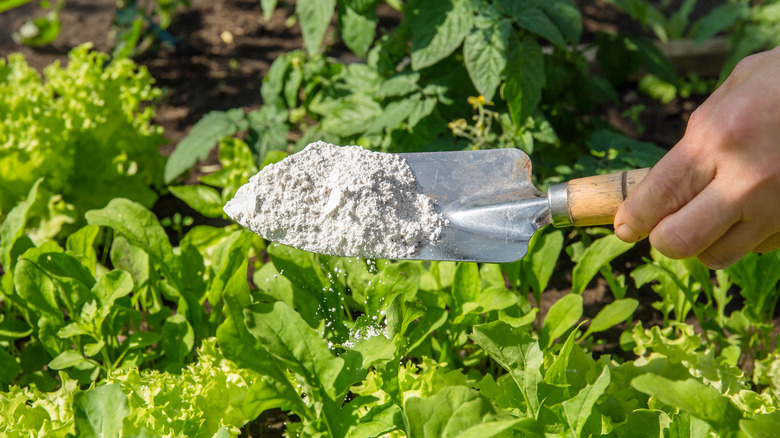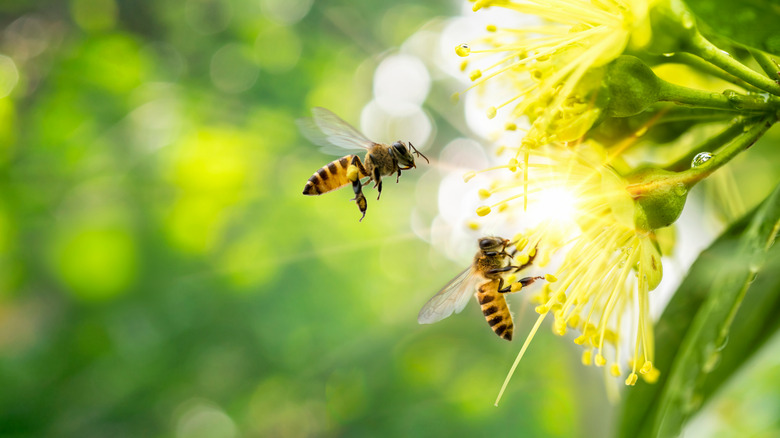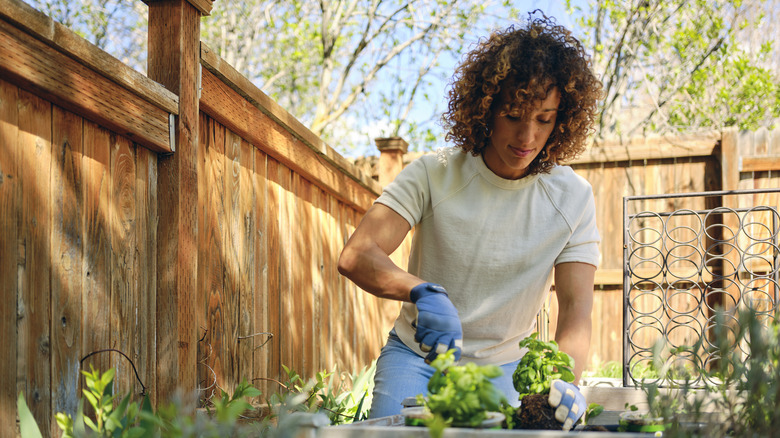You May Want To Rethink Using Diatomaceous Earth In Your Garden
In gardens, some creatures are welcome, like butterflies and bees. Others, not so much. Diatomaceous earth is one of the many ways gardeners keep unwanted pests away from their gardens — but it may not be the best method.
Diatomaceous earth is made of diatoms, a type of microscopic organism you might remember from grade-school science class. Crushed-up fossilized diatoms become diatomaceous earth, which consists of silica from diatom shells. You'll typically buy it in bags in the form of chalky white powder. Some gardeners find diatomaceous earth appealing because it's natural: it contains fossilized algae rather than artificial chemicals. It won't harm soil since it's made of a substance naturally found in soil.
As a pesticide, it sticks to the outside of insects, absorbs moisture from their bodies, and interferes with their breathing processes. Diatomaceous earth even deters slugs and snails, which will get cut if they crawl over the sharp fossilized shells.
However, it's so effective that it'll harm the beneficial creatures that visit your garden, as well as the unwanted ones. The powdery texture, unfortunately, is easy to inhale and tends to wash away in the rain, negating its power against pests. It's important to keep the problems with diatomaceous earth in mind before committing to using it in your garden.
Why you may want to avoid diatomaceous earth
The main issue with diatomaceous earth is that it's a little too good of a pesticide. While you probably want to kill the bugs that eat your plants, diatomaceous earth will also interfere with the insects you welcome, like pollinators. If you put it on or near flowers, pollinators will be especially at risk — but they can also accidentally crawl through it elsewhere in your garden.
Diatomaceous earth can pose small risks to humans and other living things, too. While it's not considered toxic, it may not be pleasant if you inadvertently breathe it in or touch it. As a fine powder made of tiny sharp objects, it's a natural irritant. It can irritate the inside of your nose, your skin, and even your eyes.
If you live in a rainy or damp area, you may also want to avoid diatomaceous earth. Rain, and even dew, can negate its abrasive, insect-killing qualities. If the diatomaceous earth you've applied gets wet, you'll have to reapply it, increasing the chances that you might breathe it in or otherwise experience its irritating qualities.
Should you ever use this pesticide?
While it's not the most harmful pesticide out there, diatomaceous earth is something you'll want to think twice before using. While the primary issue is that it also kills beneficial bugs, the risk of irritation and the need for reapplication can make it annoying and impractical to use. However, if you're experiencing a major pest problem, you might still reach for diatomaceous earth as a temporary, non-toxic fix.
If you do buy diatomaceous earth, make sure to choose the food-grade variety rather than the pool-grade one. Pool-grade diatomaceous earth contains extra chemicals and additives, so it can actually harm plants, as well as pose risks to humans and pets.
Using food-grade diatomaceous earth can help get you out of a sticky pest situation, but it's not a good long-term garden additive. You're more likely to have a successful garden if you focus on welcoming pollinators and other beneficial insects rather than using diatomaceous earth to kill insects across the board. Too much diatomaceous earth will remove the pollinators, decomposers, and other friendly creepy-crawlies gardens need.
Instead of relying on diatomaceous earth, consider other options, like building a basil "barrier" to deter unwanted pests. Solutions like this repel bugs rather than killing them, creating a safer environment for the beneficial bugs you want to keep around.


